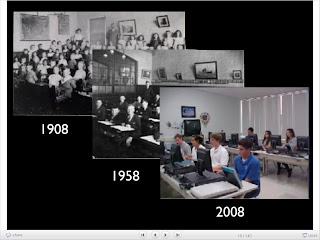
This month, I worked with
Tony Karrer to help create the
ASTD Big Question (which always seems to be multiple questions under one big theme.) The main question is
Learning design differences for Digital Natives? Of course I have strong opinions on the topic due to the fact that I've written about it many times and I spend all day with digital natives at Bloomsburg University.
I'm having trouble deciding if I should rant on this topic or try to build a rational argument so I think this post will be a bit of both. Let me rant first...
Yes, yes and yes. We need to redesign training to meet the expectations of the digital natives...we need to run away from boring, page turning e-learning courses and provide Just-in-Time learning opportunities, we need to think outside the course and consider communities, learners teaching learners and we need to enable the use of gadgets for learning...do you text message anything to your learners? Stand up training isn't going away but it needs to be reconfigured...let's incorporate (when they make sense) more interactive learning experiences, more games and more technology...not for the sake of technology but for the sake of improving learning. Use technology when it improves learning and don't use it when it doesn't...Getting back to a more scholarly approach...The sub-questions for this month's big question are:
- Do you believe that we have to design, develop and deliver instruction differently for the so-called Digital Natives?
- Are there differences in learning expectations and styles or can we just design good instruction and know that it meets all generational needs?
- If you have an audience that includes natives and immigrants, how can you effectively design instruction without breaking the bank?
First of all, some definitions are in order,
Digital Native is someone who has grown up with technology. For example, someone born in 1994 was born the same year that
Newsweek Magazine named the Internet "Person of the Year." This means such a person (in the US) has never known a time when the Internet was not a major contributor to culture, society and learning. This is also a group of individuals who have grown up in a culture influenced by the proliferation of video games, that is why I tend to use the term "Gamer" to describe the people who have grown up influenced by video games. Also, understand these terms are generalizations and there are exceptions on both sides of the term but the attempt is to provide a general description of what we must do as instructional designers, trainers or educators to reach these gamers.
A
Digital Immigrant is someone who has had to adapt to technology along the way...didn't have computers until college or late high school.
So,
Do we have to design, develop and deliver instruction differently for the Digital Natives?the answer is "Yes." This is due to expectations, capabilities and the overwhelming amount of information people are now required to know on the job.
Enter rant, As designers and people who deliver instruction we MUST reconfigure our training programs to meet the new needs of the Digital Natives. We can't lead them into a classroom and lecture to them on sales techniques after FORCING them to turn off computers, cell phones and other technologies...hey don't they use these technologies to schedule appointments, track customers and perform other job related tasks...perhaps we should incorporate those tools into the training process. Perhaps we should create training that can be leveraged by these tools. Tools that, if left behind, they stop the car and return home to get them before they continue on with the day...that is how important these tools have become. We can't ignore them when we have a training class.The next question,
Are there differences in learning expectations and styles or can we just design good instruction and know that it meets all generational needs? There are differences is uses of technology in attention spans and in processing of information. (See
Chapter One of Gadgets, Games and Gizmos for Learning). We are naive to think that a generation who has grown up during a certain time is not influenced by the technology...they are, they are shaped by it. They are dependent on it...they learn with it. If we don't use those techniques, concepts and approaches in our training programs...we are losing huge opportunities to help them learn. Good instructional strategies are still good instructional strategies but we need to be more creative in how we deploy those strategies and leverage technologies to provide good strategies. Perhaps technologies has allowed us to now maximize learning...for example, we've always known that the sooner a learner receives feedback, the higher the retention of the learning. With educational video games, feedback can be instant as opposed to a classroom where you might not get feedback until you take a quiz on the content.
Finally, "If you have an audience that includes natives and immigrants, how can you effectively design instruction without breaking the bank?" I've written on the topic before so here are some ideas.
Acknowledge to the class that their are multiple generations within the class and that each generation may have a different preference for learning and different expectations. Often people aren't aware of what causes generational differences...they just know that the "kids have no work ethic" or that "he expects me to stop my life to work on this project." So, one of your jobs as an instructor is to let all of your learner know that there are differences and that some of them are related to the different experiences of each generation....Another technique is team up the learners based on generation. Team a Gamer/Millennial with someone from the Silent Generation or from the Boomer Generation.
Mix up your own approach. Chances are, you teach or train based on your own preferences. Get out of your comfort zone and begin to involve other techniques that appeal to different generations. Have some online assignments, group assignments, in class games and don't forget a little lecture. Also, have the learners teach each other (using guidelines you create.) Try to mix things up every 10 minutes or so.
Also, when making a point or presenting examples of concepts or ideas you are teaching, use multiple examples. Try to think of an example or metaphor that would cover several generations or pick on per generation. Have your learners develop these types of metaphors that meets their own preference. Learner creation is a power tool for retention and recall.
For the entire blog entry on the subject, see
Teaching/Training Across the GenerationsSo yes, we must think differently about instructional design and the learning events we create because of the expectations, habits and learning styles of the digital natives (or as some people call them...digital savages.) If you are interested in learning more about the subject, you can see the web site
Gadgets, Games and Gizmos for Learning and read some whitepapers, articles, acquire a book on the topic and even see some examples of instruction designed for these digital natives.
Thanks to Tony for the question.
__
Catalog of Recommended Books, Games and GadgetsRecommended Games and GadgetsRecommended BooksContent Guide




























